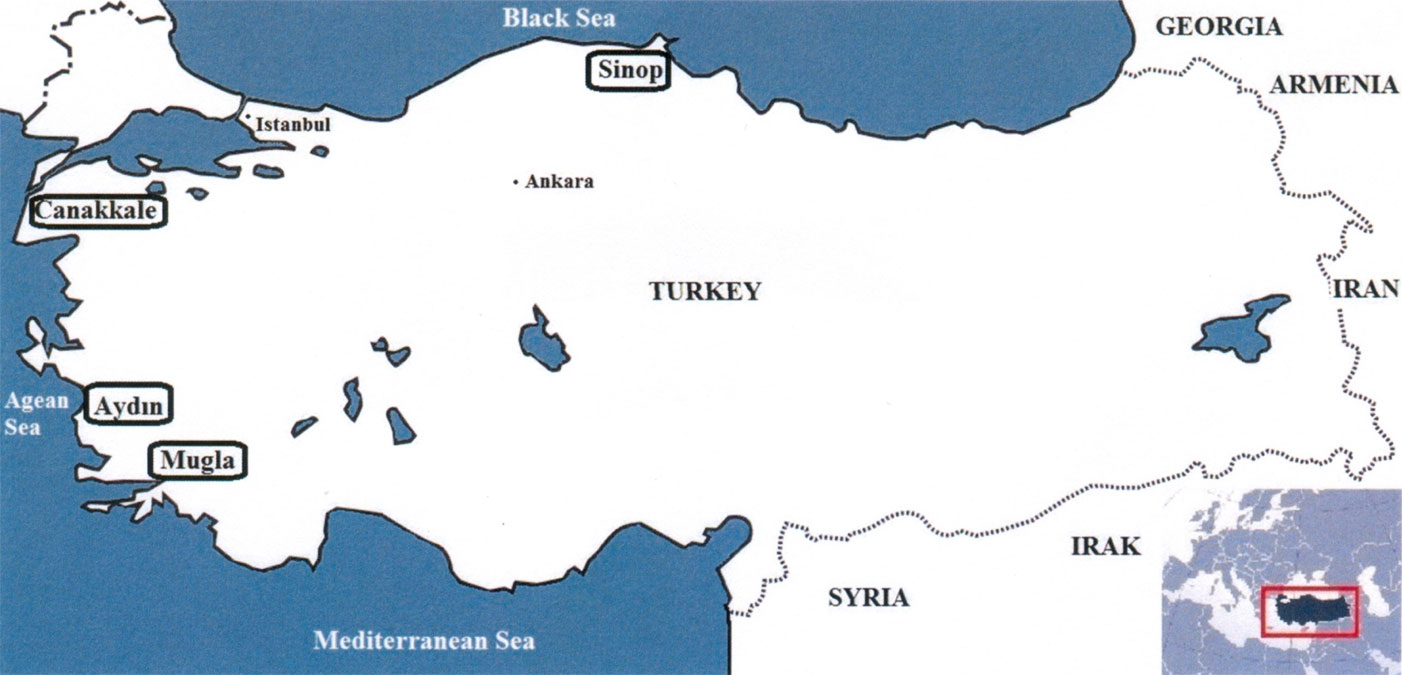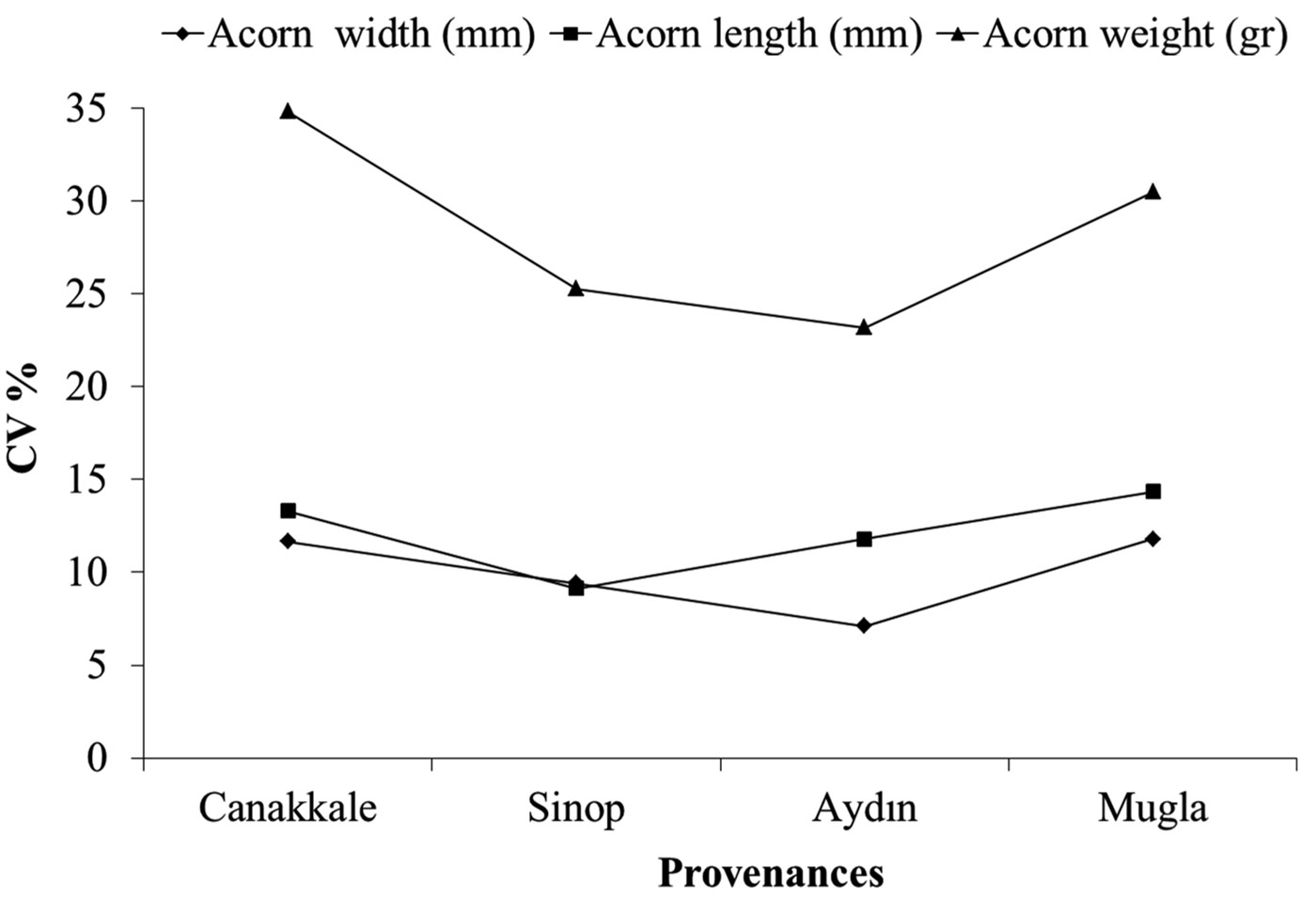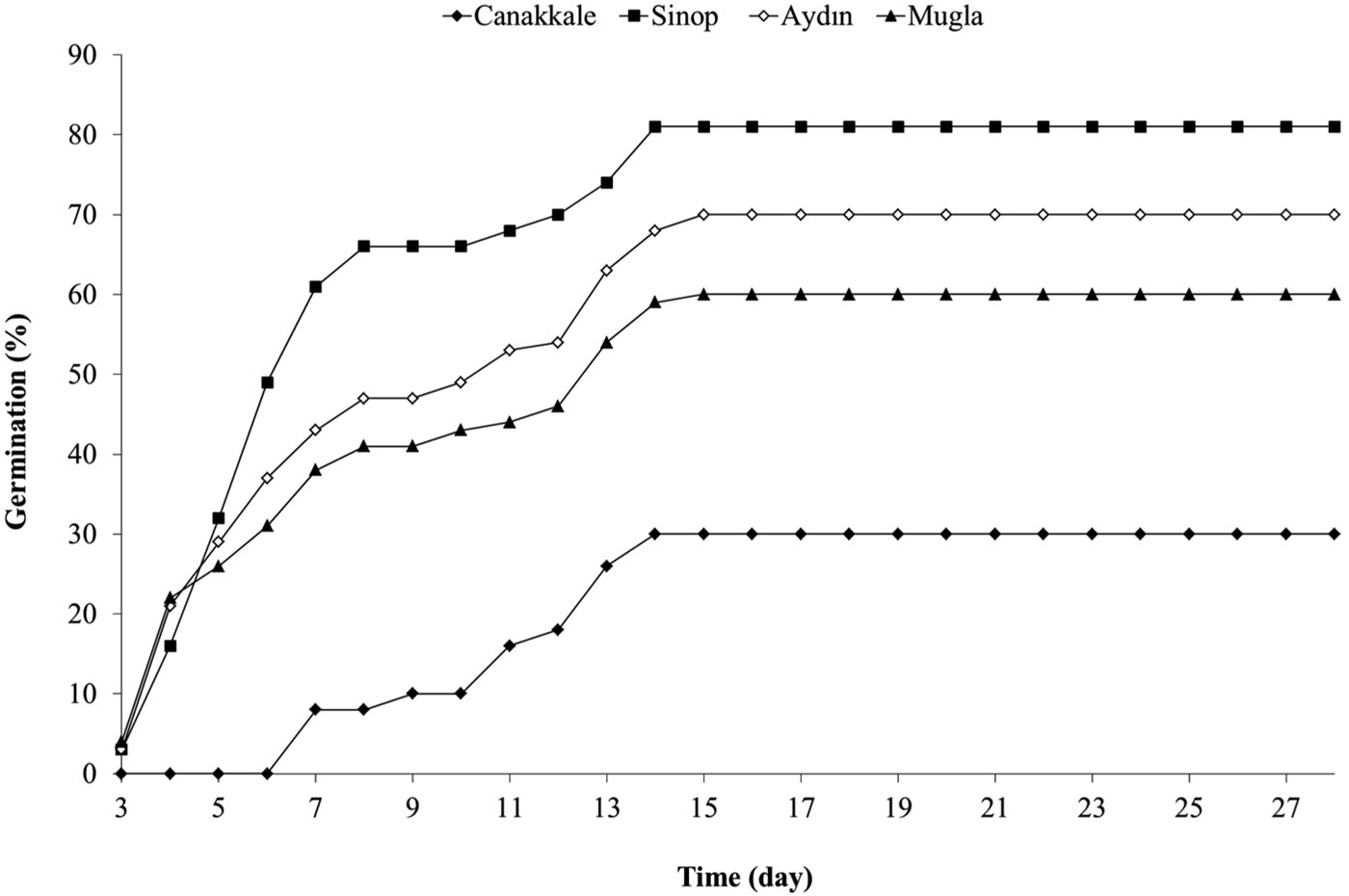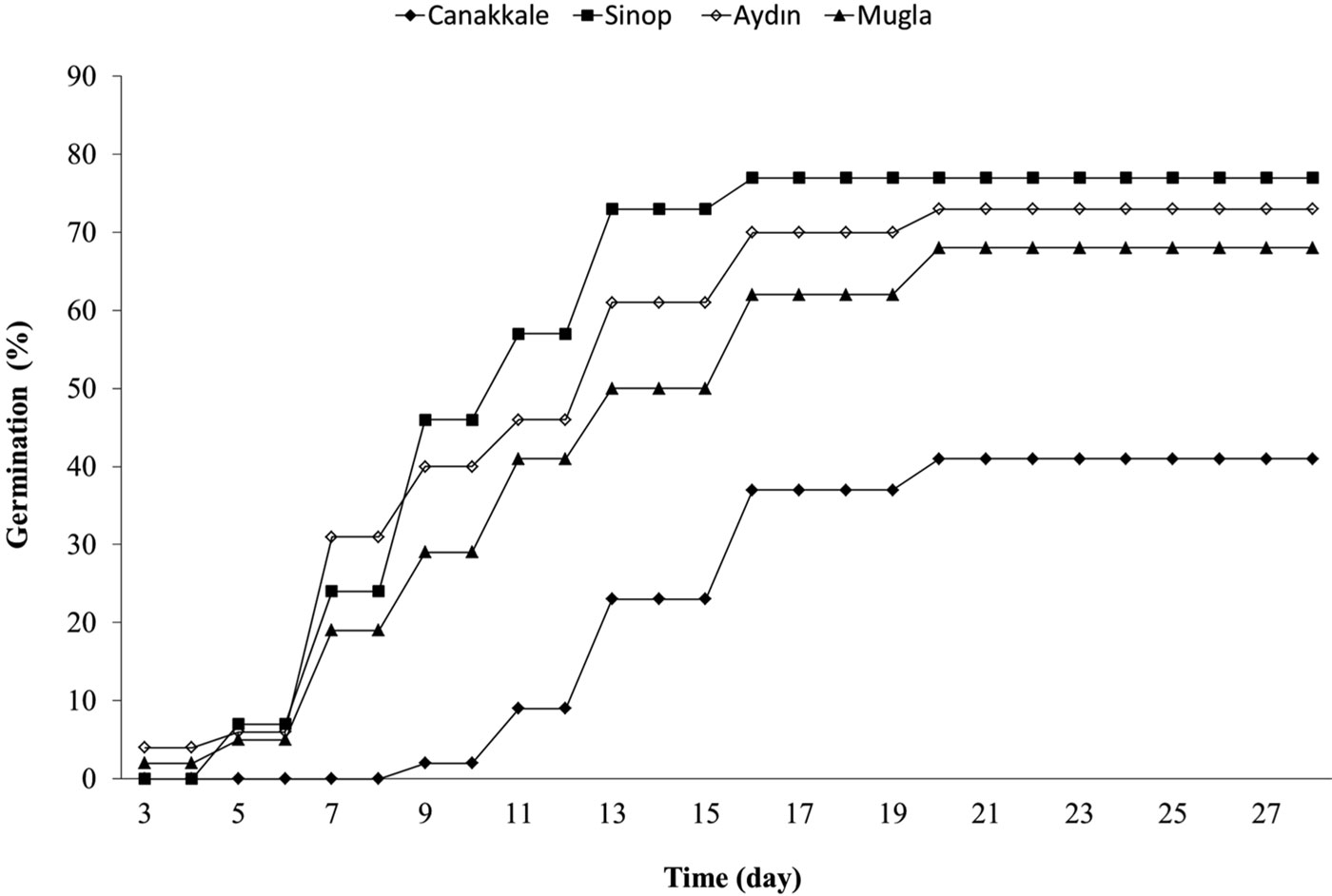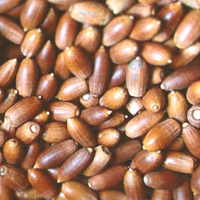
Germination and seedling growth of holm oak (Quercus ilex L.): effects of provenance, temperature, and radicle pruning
iForest - Biogeosciences and Forestry, Volume 7, Issue 2, Pages 103-109 (2014)
doi: https://doi.org/10.3832/ifor0967-007
Published: Dec 18, 2013 - Copyright © 2014 SISEF
Research Articles
Abstract
This study tested acorn characteristics and the germination behavior of different provenances of Holm oak (Quercus ilex L.) and the effects of radicle clipping of germinated acorns on 1-0 year-old seedling morphology and their field performances. The results revealed that all acorn characteristics among different provenances were significant. Quercus ilex acorns germinated well at alternating temperatures of 20/10 ºC compared to a constant 20 ºC temperature. Radicle clipping of Q. ilex significantly increased the shoot height and root collar diameter. The average number of main roots resulting from radicle clipping was 2.8 times more than unclipped treatment. The results can contribute to nursery practices and artificial regeneration of this species.
Keywords
Holm Oak, Seed Germination, Radicle Pruning, Quercus ilex, Sowing, Artificial Regeneration
Introduction
The genus Quercus includes over 500 species worldwide ([38]), of which 18 are present in Turkey ([29]). Approximately 5.15 million ha of Turkish forests were covered by oak forests and more than half of this area (3.05 million ha) is degraded ([3]). Quercus ilex (Holm oak), is an evergreen oak species that can be found both in shrub and tree forms ([57]), in pure or mixed stands, and is a typical Mediterranean sclerophyll species ([42]). The holm oak is distributed primarily in three distinct areas: (i) north Africa from Tunisia to Morocco; (ii) on several large islands, e.g., Crete, Sicily, and Corsica; and (iii) in southern (continental) Europe, along a continuum from Turkey to Portugal ([35]). In Turkey, Q. ilex occurs in western Black Sea coasts and in south-western Anatolia mixed with other pseudo-maquis and maquis species, respectively. Maquis is the dominant vegetation type growing in Mediterranean climate conditions ([8], [30]).
Heavy degradation of vegetation in large areas of the Mediterranean basin call for rehabilitation with native coniferous and broadleaves species ([8]). Mediterranean landscapes have been modified since long time by human activities. Fire, grazing pressure, shifting agriculture, and overcutting for fuel and other purposes are important degradation and/or selection factors in all the Mediterranean countries ([4], [36], [18], [37], [9], [58], [55], [8]). Moreover, it is expected that climate change could make Mediterranean ecosystems even more vulnerable ([23], [56], [26]). A decrease in Mediterranean shrublands cover might accelerate soil degradation and erosion ([28], [26]). The Holm oak plays a vital role in soil and water conservation and its acorns are important nourishment for many wild and domestic animals ([47], [45], [33]). On the other hand, Quercus ilex is an element of maquis vegetation that can play an important role in the rehabilitation and restoration of the western and eastern Mediterranean countries. Holm oak gains more interest for Mediterranean forestry, along with other evergreen species such as Quercus suber, Ceratonia siliqua, and Olea europaea, especially in restoration and reforestation activities ([19]). Similarly, Holm oak plays an important role in reforestation programs in Spain ([44], [19]), and in restoration and rehabilitation programs of degraded maquis and forest areas in Turkey.
Successful restoration and rehabilitation in Mediterranean areas strongly depend on the quality of seeds and seedligs used. So far, the influence of oak species seedling quality on artificial regeneration performance has received little attention. Moreover, fibrous rooted seedlings are highly desirable for restoration and rehabilitation activities, especially in Mediterranean countries. Such seedlings may be produced by undercutting or transplanting, though this is generally expensive and time consuming ([10]). However, it has been reported that pruning of the emerged radicle promotes the branching of the taproot in several oak species ([6], [34], [17], [52], [13]). Bonner ([7]) also stated that sowing pre-germinated acorns with damaged radicles resulted in multiple branched taproots in two southern red oak (Quercus falcata var. pagodaefolia and Quercus shumardii). Seedlings may benefit of branched multiple taproots in that root surface area becomes larger than that of seedlings with a single taproot ([13]).
A limited number of investigation have been carried out regarding Holm oak in maquis vegetation ([40], [30]), and oak seed and seedling morphology in Turkey ([16], [21], [17], [52]). Information on morphological variation in seed characteristics among the natural populations of a species is useful for tree improvement programs in that survival, growth and biomass allocation performances of seedlings largely depend on seedling quality ([48]). The objectives of this study were to determine: (a) acorn characteristics and germination behavior of different provenances of Quercus ilex; and (b) the effects of radicle clipping of germinated acorns on 1-0 year Holm oak seedling morphology, in order to assess their future field performances in rehabilitation and planting programs.
Material and methods
Acorn collection and determination of morphometric characteristics
Acorns were collected from mature trees in Canakkale (40° 10’ N, 25° 50’ E, elevation 175 m a.s.l.), Sinop (40° 01’ N, 35° 00’ E, 50 m a.s.l.), Aydin (37° 39’ N, 27° 05’ E, 10 m a.s.l.), and Mugla (36° 43’ N, 27° 32’ E , 850 m a.s.l.- Fig. 1). The climate at all sites is a typical maritime climate. The annual mean precipitation and annual mean temperature are respectively: 521 mm and 14 °C in Sinop; 513 mm and 15 °C in Canakkale; 525 mm and 18 °C in Aydin; and 979 mm and 15 °C in Mugla ([54]). Bedrocks in all sites are mainly limestone.
Collected acorns were placed in partially sealed plastic bags and transported to the laboratory. Acorns were floated in water to eliminate insect damaged or dead acorns. Sinking acorns were then selected if no damage was visible. Weight, length, and width were singly measured on 100 randomly drawn seeds from each provenance in five replications each of 20 seeds. The coefficient of variation (CV) was determined based on the overall mean and total variance for each measured trait.
Germination tests
Germination tests were carried out on 18 x 11 x 4.5 cm trays in a germination chamber. Trays were filled with sieved sand, autoclaved at 121 °C for 20 minutes, and then acorns placed on moist sand. Tests were performed with five replicates of 20 acorns for each provenance. Trays were examined daily for 30 days following the first signs of germination. Seeds were considered germinated when radicles were more than 5 mm long and showing geotropism.
Germination tests were carried out at constant (20 ± 0.5 °C) and alternating (20/10 ± 0.5 °C) temperatures. Germination data were expressed as germination percentage (GP), peak value (PV), and germination value (GV). GP is the percentage of seeds germinated at the end of the test. PV is the highest number obtained dividing GP by the number of days elapsed. GV was calculated as follows ([14] - eqn. 1):
where GV is the germination value, dGS is daily germination speed, N is the frequency or the number of dGS calculated during the test, Ngs is the number of germinated seeds, and 10 is a constant.
Seedling growth and radicle pruning
Pre-germinated acorns from Sinop and Mugla provenances were analysed for seedling morphology, and sowed in a forest nur-sery in Istanbul-Bahçeköy. The nursery is located 41° 10’ N, 28° 59’ E, and elevation 116 m a.s.l. The climate at the nursery is a humid, mesothermal, and maritime climate with a moderate water deficit over summer months according to the Thornthwaite’s classification method. Annual mean precipitation is around 1091 mm, and mean annual temperature is 12.8 °C. Most of the precipitation falls between October and March ([5], [41], [2]).
Acorns were divided into two different groups: radicles left intact and radicles pruned back to 0.5 cm. Acorns were individually sown on seedbeds with five replicates of 12 acorns for each treatment. Survival percentage, shoot height, root collar diameter, number of main roots, total diameter of main roots, and total diameter of main roots / root collar diameter were determined in 1-0 year Holm oak seedlings.
Data analysis
Parameters related to germination, such as germination percentage, peak value, and germination value, were considered as dependent variables in the analysis of variance carried out. Germination percentages were transformed using arcsine square root transformation. Population, temperature, and replications were used as independent variables (predictors). ANOVA for the germination traits were based on the following model ([49] - eqn. 2):
where Yijkl is the observed value of k-th replication of the j-th temperature of the i-th population (provenance), μ is the overall mean, Pi the population effect, Tj the effect of temperature, Rk the effect of replication, and eijk is the error.
In the radicle pruning treatments, seedling traits such as survival, shoot height, root collar diameter, number of main roots, total diameter of main roots, and total diameter of main roots (mm) /root collar diameter (mm) (dependent variables) were analyzed using treatments as independent variables. Survival percentages were transformed using arcsine square root transformation. ANOVA for the radicle pruning treatments were based on the following model ([49] - eqn. 3):
where Yij is the observation of j-th seedling of the i-th treatment, μ is the overall mean, Ti is the effect of treatment, and eij is the error.
Duncan’s multiple range test was applied to determine statistically significant differences among subsets (α=0.05).
Results
Results from ANOVA applied on acorn characteristics of Quercus ilex showed that differences among provenances were significant for all the traits considered (Tab. 1). The maximum range of variation in acorn width, length, and weight was observed for Mugla, Aydin, and Canakkale provenances (9.7-17.4 mm, 13.1-35.6 mm, and 0.55-4.96 gr, respectively). Largest width, length, and weight were observed for acorns from Mugla, Canakkale, and Aydin provenances, respectively. According to the results of the Duncan’s test on acorn width and weight (Tab. 1), Canakkale population is distinct from Sinop, Aydin, and Mugla provenances. As for acorn length, no significant differences were found in between Canakkale and Aydin, though they showed significant differences with both Sinop and Mugla. Maximum coefficient of variation (CV) was observed in acorn weight for all provenances (Fig. 2). For acorn weight, the maximum CV was recorded in the Canakkale provenance (34.8%) with a minimum of 23.2% in the Aydin provenance. For acorn width and acorn length, the maximum CV was observed in Mugla provenance (11.8% and 14.3%, respectively).
Tab. 1 - Morphometric characteristics of Quercus ilex L. acorns. Means within each column followed by different letters are significantly different (p<0.01). (SE): standard error.
| Provenance | Acorn width (mm) | Acorn length (mm) | Acorn weight (gr) | ||||||
|---|---|---|---|---|---|---|---|---|---|
| Mean | SE | Range | Mean | SE | Range | Mean | SE | Range | |
| Canakkale | 12.8 | 0.15 | 9.0-16.3 | 28.84 | 0.38 | 17.6-34.7 | 2.95 | 0.38 | - |
| Sinop | 13.03 | 0.12 | 10.8-16.2 | 24.41 | 0.22 | 19.0-30.9 | 2.64 | 0.07 | - |
| Aydin | 13.15 | 0.09 | 10.4-15.5 | 28.81 | 0.34 | 13.1-35.6 | 3.06 | 0.07 | - |
| Mugla | 13.66 | 0.16 | 9.7-17.4 | 26.06 | 0.37 | 14.2-33.9 | 2.90 | 0.09 | - |
| Over four provenances | 13.16 | 0.07 | 9.0-17.4 | 27.03 | 0.19 | 5.6-13.1 | 2.89 | 0.04 | - |
Fig. 2 - Coefficient of variation (CV) among different provenances for different acorn characters in Quercus ilex.
Results from ANOVA showed that GP, GV, and PV were significantly different among provenances (p=0.0001). The effect of temperatures was significant only for GV and PV (p=0.0108 and p=0.00018, respectively). Interaction between provenances and temperatures did not reveal any significant effect (Tab. 2).
Tab. 2 - Results of the ANOVA carried out on germination percentage (GP), germination value (GV) and peak value (PV) of the acorns of Quercus ilex.
| Variable | Parameter | Source of variation | ||||
|---|---|---|---|---|---|---|
| Provenance (A) |
Temperature (B) |
Interaction (A x B) |
Replications | Error | ||
| df | 3 | 1 | 3 | 4 | 28 | |
GP
|
MS | 3610.635 | 180.625 | 119.375 | 102.292 | 121.518 |
| F | 29.71 | 1.49 | 0.98 | 0.84 | - | |
| P-value | 0.000 | 0.2329 | 0.4331 | 0.4825 | - | |
GV
|
MS | 2419.881 | 761.508 | 80.797 | 214.348 | 102.204 |
| F | 23.68 | 7.45 | 0.79 | 2.10 | - | |
| P-value | 0.000 | 0.0108 | 0.5412 | 0.1232 | - | |
PV
|
MS | 51.287 | 22.695 | 1.048 | 3.933 | 1.910 |
| F | 26.85 | 11.88 | 0.55 | 2.06 | - | |
| P-value | 0.000 | 0.000 | 0.7011 | 0.1283 | - | |
Germination percentage, germination value and peak value were the highest in the Sinop provenance at both constant (20 ± 0.5 °C) and alternating (20/10 ± 0.5 °C) temperature regimes. Germination performances of Canakkale, Mugla, and Aydin provenances were higher at the alternating than at the constant temperature regime. Contrastingly, Sinop provenance acorns revealed better performances in terms of germination parameters at constant rather than alternating temperature regime (Tab. 3, Fig. 3, Fig. 4).
Tab. 3 - Germination of Quercus ilex L. acorns from four provenances at 20 °C and 20/10 °C. Means in the same column followed by different lowercase letter are significantly different (p<0.05); means in the same column followed by different uppercase letter are significantly different (p<0.05).
| Temp. Regime | Provenance | Germination Parameters | ||
|---|---|---|---|---|
| GP | GV | PV | ||
| constant (20 °C) |
Canakkale | 30 a | 5.0 a | 2.1 e |
| Sinop | 81 b | 49.0 b | 8.7 a | |
| Aydin | 70 bc | 35.6 c | 6.2 b | |
| Mugla | 60 c | 27.2 cd | 5.4 b | |
| Mean | 60 A | 29.2 A | 5.6 A | |
| alternate (20/10 °C) |
Canakkale | 41 a | 6.6 a | 2.3 de |
| Sinop | 77 b | 29.4 cd | 5.6 b | |
| Aydin | 73 bc | 22.6 cd | 4.7 cb | |
| Mugla | 68 bc | 17.5 d | 3.9 cd | |
| Mean | 65 A | 19.0 B | 4.1 B | |
Germination percentage, germination value, and peak value at 20 °C and 20/10 °C were the highest in the Sinop provenance with lowest seed weight, and the lowest in the Canakkale provenance with medium seed weight (Tab. 1 and Tab. 3).
The effects of radicle pruning of germinated acorns on 1-0 year Holm oak seedling morphology were tested. Significant differences were found in shoot height, root collar diameter, number of main roots, and total diameter of main roots/root collar diameter. On the other hand, no significant differences were observed in survival. Finally, all the seedlings from the unpruned radicle treatment had single roots, while multiple roots were observed for all seedlings from the pruned radicle treatment (Tab. 4). Overall, seedlings with radicle pruned at germination seemed to perform better than unpruned seedlings (Tab. 4).
Tab. 4 - Survival and seedling morphology from different radicle pruning treatments (average for two provenances). Means in the same row followed by different letters were significantly different (p<0.05).
| Parameters | Sowing Treatments | |
|---|---|---|
| Radicle not clipped |
Radicle clipped |
|
| Survival (%) | 66 a | 62 a |
| Shoot height (mm) | 147 a | 169 b |
| Root Collar Diameter (mm) | 3.5 a | 3.8 b |
| Number of the main roots | 1 a | 2.8 b |
| Total diameter of the main roots (mm) | 3.5 a | 7.1 b |
| Total diameter of the main roots (mm) / Root Collar Diameter (mm) |
1 a | 1.9 b |
Discussion
Most Mediterranean sclerophyllous species develop morphological and physiological adaptations to the long and dry summer period, such as small and thick leaves, dense pubescence, deep water extraction system, and high water use efficiencies ([39]). In fact, drought stress is responsible for growth and survival of evergreen woody species in the Mediterranean basin ([25]).
Local adaptations to specific ecological conditions may lead to differences among provenances in growth performances ([12], [15]). Population variability with respect to acorn morphology have been reported for Quercus ilex ([19]), Q. glauca ([48]), and Q. suber ([46]). In a study on thirteen populations of holm oak throughout Spain ([19]), differences in acorn morphology between eastern and western provenances were reported, the latter showing also larger overall variation. The authors reported acorn weight ranging from 2.4 to 6.1 g (CV = 22-37%), length ranging from 40.4 to 22.8 mm (CV = 3-17%), and diameter ranging from 17.1 to 12.4 mm (CV = 13-35% - [19]). In the present study, ranges for acorn weight, length and width were 2.6-3.1 gr, 24.4-28.8 mm, 12.8-13.7 mm, respectively. On the other hand, CV ranges for weight, length, and width were 23-35%, 9-14%, and 9-12%, respectively. Moreover, significant differences among provenances were found for all the seed traits considered in this study. Afzal-Rafii et al. ([1]) reported mean width values ranging from 12 to 13 mm for Holm oak acorns, while mean weight was 2.4-3 g, ranges similar to those observed in the present study (12.8-13.7 mm and 2.6-3.1 g, respectively).
Gomez ([22]) stated that large acorns of Q. ilex showed increased germination rate. In contrast, in the present study Canakkale provenance had the largest acorns but showed the lowest germination percentage, while Sinop provenance had the lightest acorns and the highest germination percentage. In some tree species, large seeds showed increased germination and survival ([31], [11]). On the contrary, the rule larger seeds = highest gerination rate does not hold for some other species, as it was in our study ([32], [51], [50]). However, it has been reported that acorn size and morphology are also affected by soil properties and stand characteristics ([20]).
In the present study, Q. ilex acorns showed better germination at alternating temperature regime (20/10 °C - 65%) than at constant regime (20 °C - 60%) temperature regime. However, similar differences among provenances in germination rate have been observed. Pasquini et al. ([43]) reported for Holm oak germination percentages of two seed lots (68% and 63%) very similar to those observed in the present study.
Radicle pruning has revealed a positive effect on seedling performances in this investigation, determining a larger taproot production and increasing height and root collar diameter of seedlings. Moreover, significant differences were found in shoot height, root collar diameter, number of the main roots, and total diameter of the main roots/root collar diameter of the two tested provenances, though no significant differences in seedlings’ survival were observed at the end of the growing season. However, in Quercus vulcanica radicle clipping had no effect on survival, shoot height, and diameter of seedlings obtained from spring-sown acorns ([52]). Radicle clipping had also no effect on shoot height and diameter of containerized Q. vulcanica 1-year-old seedlings from fall-sown acorns ([21]) and did not significantly alter height in Fagus orientalis ([10]). In the present study, the average number of main roots was 2.8 times higher for seedlings undergoing radicle clipping in comparison to unclipped treatment, while it was close to 2.5 times higher for radicle- pruned seedlings of Quercus vulcanica after 8 months ([52]). Radicle clipping resulted in more seedling branch roots both in Q.vulcanica ([21]) and Quercus douglasii ([34]), and in a greater terminal elongation in greenhouse conditions in northern red oak ([6]). Furthermore, radicle pruning prior to sowing did not adversely affect seedling production in two southern red oaks (Quercus shumardii and Quercus falcate var. pagodaefolia - [7]). Similar results were also obtained by Ertas ([16]) in Quercus hartwissiana, where radicle pruning doubled the average number of taproots and increased the root collar diameters of the seedlings, and by Ertas ([17]) in Quercus petraea, where root surface area and number of taproots increased in 1-0 year old radicle-pruned seedlings.
The present study confirmed the importance of radicle clipping of Q. ilex. Radicle clipping generally inhibits the development of main carrot-type tap root, and causes the formation of several tap roots and a more fibrous root systems. It is thought that such a root system may confer an advantage on seedlings, providing greater root surface area for the absorption of moisture and nutrients ([52]). Radicle-pruning tecnhiques may be adopted in nursery in order to produce vigorous material to be used in reafforestation or rehabilitation activities in drought-prone or degraded areas frequently occuring in the Mediterranean basin. Moreover, it is well-known that height and root collar diameter of seedlings are among the major factors positively affecting planting success of broad leaved species. The slow growth and poor survival of planted oaks may be in part due to the root system ([6]). Finally, Tsakaldimi et al. ([53]) highlighted that grading criteria for oak seedlings’ shoot height and root-collar diameter are important parameters to be considered for successful reafforestation of sites with high environmental stress.
Conclusion
The aim of this study was to determine the acorn characteristics, germination behaviors, and effects of radicle clipping of different provenances of Holm oak (Quercus ilex L.) from northern and western regions of Turkey. Quercus ilex acorns better germinated at alternating temperatures rather than at the constant temperature regimes. Significant differences were detected among different provenances for all the measured seed traits. Pruning the radicle of germinated acorns before sowing has proven to positively affect 1-year-old seedlings of Quercus ilex, increasing their shoot height and root collar diameter.
Acknowledgements
I wish to thank Prof. Dr. C. Unal Alptekin for his support during the seed collection. I am grateful to Prof. Dr. Melih Boydak for his careful review of and useful comments on this manuscript. I sincerely thank Dr. Bilal Cetin for his support in the laboratory during the investigation.
References
Gscholar
Gscholar
Gscholar
Gscholar
Gscholar
Gscholar
Gscholar
Gscholar
Gscholar
Gscholar
Gscholar
Gscholar
Gscholar
Gscholar
Gscholar
Gscholar
Gscholar
Gscholar
Gscholar
Online | Gscholar
Gscholar
Gscholar
CrossRef | Gscholar
Gscholar
Gscholar
Gscholar
Gscholar
Gscholar
Gscholar
Gscholar
Authors’ Info
Authors’ Affiliation
Department of Silviculture, Faculty of Forestry, Istanbul University, TR-34473, Bahcekoy, Istanbul (Turkey)
Corresponding author
Paper Info
Citation
Caliskan S (2014). Germination and seedling growth of holm oak (Quercus ilex L.): effects of provenance, temperature, and radicle pruning. iForest 7: 103-109. - doi: 10.3832/ifor0967-007
Academic Editor
Giustino Tonon
Paper history
Received: Feb 05, 2013
Accepted: Jul 31, 2013
First online: Dec 18, 2013
Publication Date: Apr 02, 2014
Publication Time: 4.67 months
Copyright Information
© SISEF - The Italian Society of Silviculture and Forest Ecology 2014
Open Access
This article is distributed under the terms of the Creative Commons Attribution-Non Commercial 4.0 International (https://creativecommons.org/licenses/by-nc/4.0/), which permits unrestricted use, distribution, and reproduction in any medium, provided you give appropriate credit to the original author(s) and the source, provide a link to the Creative Commons license, and indicate if changes were made.
Web Metrics
Breakdown by View Type
Article Usage
Total Article Views: 67772
(from publication date up to now)
Breakdown by View Type
HTML Page Views: 55947
Abstract Page Views: 4018
PDF Downloads: 6091
Citation/Reference Downloads: 33
XML Downloads: 1683
Web Metrics
Days since publication: 4377
Overall contacts: 67772
Avg. contacts per week: 108.39
Article Citations
Article citations are based on data periodically collected from the Clarivate Web of Science web site
(last update: Mar 2025)
Total number of cites (since 2014): 18
Average cites per year: 1.38
Publication Metrics
by Dimensions ©
Articles citing this article
List of the papers citing this article based on CrossRef Cited-by.
Related Contents
iForest Similar Articles
Research Articles
Influence of mother plant and scarification agents on seed germination rate and vigor in Retama sphaerocarpa L. (Boissier)
vol. 7, pp. 306-312 (online: 08 April 2014)
Research Articles
Conservation of Betula oycoviensis, an endangered rare taxon, using vegetative propagation methods
vol. 13, pp. 107-113 (online: 23 March 2020)
Technical Reports
Effects of different mechanical treatments on Quercus variabilis, Q. wutaishanica and Q. robur acorn germination
vol. 8, pp. 728-734 (online: 05 May 2015)
Research Articles
Effects of brassinosteroid application on seed germination of Norway spruce, Scots pine, Douglas fir and English oak
vol. 10, pp. 121-127 (online: 02 October 2016)
Research Articles
The effectiveness of short-term microwave irradiation on the process of seed extraction from Scots pine cones (Pinus sylvestris L.)
vol. 13, pp. 73-79 (online: 13 February 2020)
Research Articles
Effects of different nut pretreatments and substrates on germination and seedlings growth of Neocarya macrophylla Sabine in Basse Casamance, Senegal
vol. 17, pp. 346-352 (online: 03 November 2024)
Research Articles
Shrub facilitation of Quercus ilex and Quercus pubescens regeneration in a wooded pasture in central Sardinia (Italy)
vol. 3, pp. 16-22 (online: 22 January 2010)
Technical Reports
Nursery practices increase seedling performance on nutrient-poor soils in Swietenia humilis
vol. 8, pp. 552-557 (online: 09 December 2014)
Research Articles
Size and age: intrinsic confounding factors affecting the responses to a water deficit in black spruce seedlings
vol. 8, pp. 401-409 (online: 09 December 2014)
Research Articles
Optimum light transmittance for seed germination and early seedling recruitment of Pinus koraiensis: implications for natural regeneration
vol. 8, pp. 853-859 (online: 22 May 2015)
iForest Database Search
Search By Author
Search By Keyword
Google Scholar Search
Citing Articles
Search By Author
Search By Keywords
PubMed Search
Search By Author
Search By Keyword

